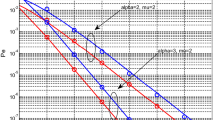Abstract
In this paper, product of two Gaussian-Q functions is represented as sum of exponentials. It is further used to evaluate error probabilities of modulation techniques in fading distributions. The knowledge of moment generating function (MGF) is sufficient enough to derive closed-form solution to integrals appearing in symbol error probability (SEP). Numerical results demonstrate accuracy improvement over other existing competing approximations. Furthermore, the proposed solutions are fairly simple as MGF of fading models comprises of fundamental mathematical functions.





Similar content being viewed by others
References
(2020) Taylor series expansion of Gaussian Q function. https://math.stackexchange.com/questions/3672516/taylor-series-approximation-of-gaussian-q-function-q-left-x-right-frac. [Online]
Aggarwal S (2019) Closed-form solutions to SEP integrals over generalized fading distributions η − μ and κ − μ using approximate computing. Int J Commun Syst 32(18):e4162
Aggarwal S (2019) A survey-cum-tutorial on approximations to Gaussian Q function for symbol error probability analysis over Nakagami- m fading channels. IEEE Communications Surveys Tutorials 21(3):2195–2223
Aggarwal S (2020) Approximate solution to SEP integral over Fluctuating Beckmann fading. Wireless Pers Commun 111:1367–1376
Aldalgamouni T, Ilter MC, Badarneh OS, Yanikomeroglu H (2018) Performance analysis of fisher-snedecor F composite fading channels. In: 2018 IEEE Middle East and North Africa Communications Conference (MENACOMM), pp 1–5
Beaulieu NC (2006) A useful integral for wireless communication theory and its application to rectangular signaling constellation error rates. IEEE Trans Commun 54(5):802–805
Bilim M (2019) QAM signaling over κ − μ shadowed fading channels. Physical Communication 34:261–271
Bilim M (2019) Some new results for integrals involving Gaussian Q-function and their applications to α − μ and η − μ fading channels. Wireless Pers Commun 109:1463–1469
Bilim M, Kapucu N (2019) Average symbol error rate analysis of qam schemes over millimeter wave fluctuating two-ray fading channels. IEEE Access 7:105746–105754
Chauhan PS, Kumar S, Soni SK (2019) New approximate expressions of average symbol error probability, probability of detection and auc with mrc over generic and composite fading channels. AEU - Int J Electron Commun 99:119–129
Chiani M, Dardari D, Simon MK (2003) New exponential bounds and approximations for the computation of error probability in fading channels. IEEE Trans Wireless Commun 2(4):840–845
Ermolova NY (2009) Useful integrals for performance evaluation of communication systems in generalized η − μ and κ − μ fading channels. IEEE Comm 3(2):303–308
Isukapalli Y, Rao BD (2008) An analytically tractable approximation for the Gaussian Q-function. IEEE Commun Lett 12(9):669–671
Kapucu N (2019) Error performance of digital modulations over Fisher-Snedecor \(\mathcal {F}\) fading channels. AEU - Int J Electron Commun 108:73–78
Karagiannidis GK, Lioumpas AS (2007) An improved approximation for the Gaussian Q-function. IEEE Commun Lett 11(8):644–646
Kaur M, Yadav RK (2020) Performance analysis of beaulieu-xie fading channel with mrc diversity reception. Trans Emerg Telecommun Technol, pp e3949. https://doi.org/10.1002/ett.3949
Kumar S, Jain P (2017) Micro-diversity analysis of error probability and channel capacity over hoyt-gamma fading. Radioengineering 26:1096–1103. https://doi.org/10.13164/re.2017.1096
Kumar S, Soni SK, Jain P (2018) Performance of mrc receiver over hoyt-lognormal composite fading channel. Int J Electron 105(9):1433–1450
Li R, Kam PY (2007) Averages of the product of two Gaussian Q-functions over fading statistics and applications. IEEE Commun Lett 11(1):58–60
Lopez-Benitez M (2015) Average of arbitrary powers of Gaussian Q-function over η-μ and κ-μ fading channels. Electron Lett 51(11):869–871
Loskot P, Beaulieu NC (2009) Prony and polynomial approximations for evaluation of the average probability of error over slow-fading channels. IEEE Trans Veh Technol 58(3):1269–1280
Mallik RK (2008) Average of product of two Gaussian Q-functions and its application to performance analysis in Nakagami fading. IEEE Trans Commun 56(8):1289–1299
Olabiyi O, Annamalai A (2012) Invertible exponential-type approximations for the Gaussian probability integral Q(x) with applications. IEEE Wireless Commun Lett 1(5):544–547
Paris JF (2014) Statistical characterization of κ − μ Shadowed fading. IEEE Trans Veh Technol 63(2):518–526
Radaydeh RM (2007) Average SEP of rectangular QAM in Rayleigh fading with GSC. IEEE Comm Letters 11(6):492–494
Ramirez-Espinosa P, Lopez-Martinez FJ, Paris JF, Yacoub MD, Martos-Naya E (2018) An extension of the κ-μ shadowed fading model: Statistical characterization and applications. IEEE Trans Veh Technol 67(5):3826–3837
Rasethuntsa TR, Kumar S (2019) An integrated performance evaluation of ed-based spectrum sensing over α − κ − μ and α − κ − μ-extreme fading channels. Trans Emerg Telecommun Technol 30(5):e3569
Rasethuntsa TR, Kumar S, Kaur M (2019) A comprehensive performance evaluation of a df-based multi-hop system over α − κ − μ and α − κ − μ-extreme fading channels. arXiv: Information Theory
Rugini L (2016) Symbol error probability of hexagonal QAM. IEEE Commun Lett 20(8):1523–1526
Sadhwani D, Yadav RN (2020) A comprehensible form of the product of two Gaussian Q functions and its usefulness in κ − μ shadowed fading distribution. J Franklin Inst 357(8):5110–5123
Sadhwani D, Yadav RN, Aggarwal S (2017) Tighter bounds on the Gaussian Q function and its application in Nakagami-m fading channel. IEEE Wireless Commun Lett 6(5):574–577
Sadhwani D, Yadav RN, Aggarwal S, Raghuvanshi DK (2018) Simple and accurate SEP approximation of hexagonal-QAM in AWGN channel and its application in parametric α − μ, η − μ, κ − μ fading, and log-normal shadowing. IET Communications 12(5):1454–1459
Shi Q, Karasawa Y (2011) An accurate and efficient approximation to the Gaussian Q-function and its applications in performance analysis in Nakagami-m fading. IEEE Commun Lett 15(5):479–481
Simon MK, Alouini MS (2005) Digital Communication over Fading Channels, 2nd edn. Wiley, Hoboken
Author information
Authors and Affiliations
Corresponding author
Additional information
Publisher’s note
Springer Nature remains neutral with regard to jurisdictional claims in published maps and institutional affiliations.
Rights and permissions
About this article
Cite this article
Aggarwal, S. Product of two Gaussian Q-functions as sum of exponentials and its applications. Ann. Telecommun. 77, 151–161 (2022). https://doi.org/10.1007/s12243-021-00864-w
Received:
Accepted:
Published:
Issue Date:
DOI: https://doi.org/10.1007/s12243-021-00864-w




